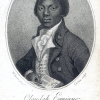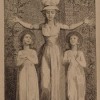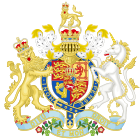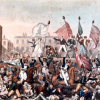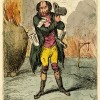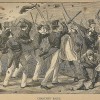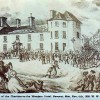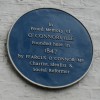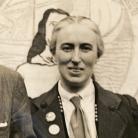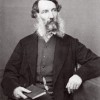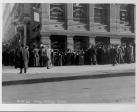Timeline: Race, Gender, Class, Sex
Created by Dino Franco Felluga on Tue, 08/24/2021 - 12:56
Part of Group:
 This timeline is part of ENGL 202's build assignment. Research a topic that teaches us something about race, class, gender, or sexuality and then contribute what you have learned to our shared class resource. As the assignment states, "Add one timeline element, one map element and one gallery image about race, class, gender, or sex to our collective resources in COVE Editions. Provide images, sources and sufficient detail to explain the historical or cultural element that you are presenting. Interlink the three objects." A few timeline elements have already been added (borrowing from BRANCH).
This timeline is part of ENGL 202's build assignment. Research a topic that teaches us something about race, class, gender, or sexuality and then contribute what you have learned to our shared class resource. As the assignment states, "Add one timeline element, one map element and one gallery image about race, class, gender, or sex to our collective resources in COVE Editions. Provide images, sources and sufficient detail to explain the historical or cultural element that you are presenting. Interlink the three objects." A few timeline elements have already been added (borrowing from BRANCH).
Timeline
Chronological table
| Date | Event | Created by | Associated Places | |
|---|---|---|---|---|
| 9 Apr 1787 |
First settlers depart for Sierra Leone
Articles |
Dave Rettenmaier | ||
| Jan 1789 |
Interesting Narrative of the Life of Olaudah Equiano
Articles |
Dave Rettenmaier | ||
| 1 Jan 1792 |
Vindication of the Rights of Woman
ArticlesAnne K. Mellor, "On the Publication of A Vindication of the Rights of Woman" Related Articles |
Dave Rettenmaier | ||
| 10 Sep 1797 |
Death of Wollstonecraft
ArticlesAnne K. Mellor, "On the Publication of A Vindication of the Rights of Woman" |
Dave Rettenmaier | ||
| Jan 1798 |
Memoirs of the Author of a VindicationOn January 1798, publication of William Godwin’s Memoirs of the Author of A Vindication of the Rights of Woman. The publication of this first biography of Wollstonecraft causes a scandal and Godwin publishes a second “corrected” edition of the Memoirs in the summer of the same year. ArticlesRelated ArticlesAnne K. Mellor, "On the Publication of A Vindication of the Rights of Woman" |
Dave Rettenmaier | ||
| 22 Jun 1802 |
Criminal Jurisdiction Act passed
Articles |
Dave Rettenmaier | ||
| 18 Jan 1819 |
St. Peter's Field meetingOn 18 January 1819, Henry Hunt presided at a meeting of 8,000 operatives on St. Peter’s Field in Manchester. Articles |
Dave Rettenmaier | ||
| 15 Feb 1819 |
Sandy Brow FightOn 15 February 1819, William Fitton presided at a public meeting at Sandy Brow in Stockport (the so-called “Sandy Brow Fight”), number present not known, where a scuffle involving stones and brickbats occurred over an attempt by the military to seize the Cap of Liberty; the Riot Act was read three times. Articles |
Dave Rettenmaier | ||
| 14 Jun 1819 |
Ashton-under-Lyne meetingOn 14 June 1819, Joseph Harrison presided at a meeting of 12,000–15,000 at Ashton-under-Lyne; this was typical of a spate of June meetings at Oldham, Bolton, Royton, Bury, Heywood, Stockport, Failsworth, Gee Cross, Lees, Middleton, Rochdale, Todmorden, Barnsley, Holmfirth, Leeds, and other towns that were unrepresented in Parliament. Articles |
Dave Rettenmaier | ||
| 16 Jun 1819 |
Glasgow meeting of weaversOn 16 June 1819, 40,000 weavers met at Glasgow to petition the Prince Regent for passage money to Canada for the unemployed. Articles |
Dave Rettenmaier | ||
| 28 Jun 1819 |
Stockport meetingOn 28 June 1819, at the great Stockport meeting, the largest of its kind besides Peterloo, upwards of 20,000 assembled to hear Sir Charles Wolseley speak on Parliamentary reform. Articles |
Dave Rettenmaier | ||
| 16 Aug 1819 |
Peterloo massacre
Related ArticlesJames Chandler, “On Peterloo, 16 August 1819″ Sean Grass, “On the Death of the Duke of Wellington, 14 September 1852″ |
Dave Rettenmaier | ||
| 2 Sep 1819 |
Westminster meetingOn 2 September 1819, 15,000–50,000 people assembled in Westminster and were addressed by Francis Burdett and Major Cartwright. The Examiner for that date confirmed 2 September as the correct date. This followed a smaller protest meeting at Smithfield the week before. Articles |
Dave Rettenmaier | ||
| 1 Nov 1819 |
Simultaneous radical meetingsOn 1 November 1819, simultaneous meetings were held, by prior agreement, at Newcastle, Carlisle, Leeds Halifax, Manchester, Bolton, Nottingham, Leicester, Coventry, and elsewhere in England and Scotland. Articles |
Dave Rettenmaier | ||
| 15 Nov 1819 |
Simultaneous Scottish radical meetingsOn 15 November 1819, simultaneous radical meetings occurred at Paisley, Glasgow, and other locations across Scotland. Articles |
Dave Rettenmaier | ||
| 30 Dec 1819 |
Gag Acts
Articles |
Dave Rettenmaier | ||
| Aug 1830 to Dec 1830 |
Swing Riots
Related ArticlesCarolyn Lesjak, "1750 to the Present: Acts of Enclosure and Their Afterlife" (forthcoming) |
Dave Rettenmaier | ||
| 29 Aug 1833 |
Slavery Abolition Act
Articles |
Dave Rettenmaier | ||
| 14 Jun 1839 |
First Chartist Petition
ArticlesChris R. Vanden Bossche, "On Chartism" Related ArticlesJo Briggs, “1848 and 1851: A Reconsideration of the Historical Narrative” |
Dave Rettenmaier | ||
| Nov 1839 |
Newport Uprising
ArticlesChris R. Vanden Bossche, "On Chartism" Related ArticlesJo Briggs, “1848 and 1851: A Reconsideration of the Historical Narrative” |
Dave Rettenmaier | ||
| 2 May 1842 |
Second Chartist Petition
ArticlesChris R. Vanden Bossche, "On Chartism" Related ArticlesJo Briggs, “1848 and 1851: A Reconsideration of the Historical Narrative” |
Dave Rettenmaier | ||
| 8 Aug 1842 |
Manchester strike
ArticlesChris R. Vanden Bossche, "On Chartism" Related ArticlesJo Briggs, “1848 and 1851: A Reconsideration of the Historical Narrative” |
Dave Rettenmaier | ||
| Apr 1846 |
Formation of the Chartist Land Company
Articles |
Dave Rettenmaier | ||
| 17 Aug 1846 |
Opening festival for O’Connorville
Articles |
Dave Rettenmaier | ||
| 10 Apr 1848 |
Chartist Rally, Kennington
Led by Feargus O’Connor, an estimated 25,000 Chartists meet on Kennington Common planning to march to Westminster to deliver a monster petition in favor of the six points of the People’s Charter. Police block bridges over the Thames containing the marchers south of the river, and the demonstration is broken up with some arrests and violence. However, the large scale revolt widely predicted and feared fails to materialize. ArticlesJo Briggs, “1848 and 1851: A Reconsideration of the Historical Narrative” |
Dave Rettenmaier | ||
| 1 Jul 1848 |
Trial of Chartist leaders
The summer of 1848 witnesses violence as Chartist leaders are arrested and secret plots against the government are infiltrated. By the end of August, after the arrest of several hundred Chartists and Irish Confederates, the movement for violent uprising in England is broken. ArticlesJo Briggs, “1848 and 1851: A Reconsideration of the Historical Narrative” |
Dave Rettenmaier | ||
| Dec 1849 |
Carlyle's "Negro Question"
Articles |
Dave Rettenmaier | ||
| Aug 1851 |
Chancery Court orders closing of O’Connorville
Articles |
Dave Rettenmaier | ||
| 10 May 1857 to 20 Jun 1858 |
Indian Uprising
ArticlesPriti Joshi, “1857; or, Can the Indian ‘Mutiny’ Be Fixed?” Related ArticlesJulie Codell, “On the Delhi Coronation Durbars, 1877, 1903, 1911″ |
Dave Rettenmaier | ||
| 1858 |
English Woman’s Journal first published
Articles |
Dave Rettenmaier | ||
| 14 Jan 1858 |
Failed Assassination Attempt Leads to the Construction of the Palais GarnierOn January 14th, 1858, Napoleon III (President of France) and his wife rode by carriage to a show at the rue Le Peletier, a popular Paris Opera venue. As they arrived and attempted to step out, bombs were thrown with the attempt of killing the President. The assassin was Felice Orsini, an Italian nationalist revolutionary, who wished to incite a revolution in France that would spread to Italy. His attempt failed, as the King and wife were uninjured but several others were killed. Orsini was arrested and sentenced to death, but his actions did lead to Napoleon III declaring war on Austria in 1859, leading to Italy’s independence. After such a close encounter to death, the President was troubled by his lack of safety during times of enjoyment. This inspired the idea for the construction of a new opera house-- one with a separate and secure entrance for him. From this arose the Palais Garnier, a widely known ballet and opera house owned by the Paris Opera Company. Highly decorated with elaborate marble carvings and medallions stamped “N” for Napoleon III, this building was designed with the rich, high class members of Paris as priority. The performance stage was designed at an angle to allow all spectators a proper view, and “subscribers” who paid a regular fee were granted exclusive access behind the stage in an area known as the foyer de la danse. This area became known for exploitation among the performing women and girls in training, as they could not make a livable wage from the Paris Opera Company and many times were financially responsible for their family. In return for sexual favors, the girls would receive money, private lessons, a home to live in, among other things. Many times this was bound in contract, the contracts even written and agreed upon between the “patron” and the girl’s own mother. Despite the prestige and grace held for the art of ballet, the ballerinas themselves were seen by society as simply well-dressed prostitutes, whether they had accepted the advances of wealthy men or not. “Felice Orsini.” Encyclopædia Britannica, Encyclopædia Britannica, Inc.,https://www.britannica.com/biography/Felice-Orsini. Pierre. “Palais Garnier - Explore Paris' Prestigious Opera House.” French Moments, 28 Feb. 2020, https://frenchmoments.eu/palais-garnier-paris/. |
Liliona Blunt | ||
| Jun 1858 |
Sale of the final piece of Chartist propertyJune 1858 saw the sale of the final piece of Chartist property, definitively bringing to an end the efforts of the Chartist Cooperative Land Company. The Chartist Land Company was a large-scale, explicitly political version of freehold societies. Conceived by the Chartist leader Feargus O’Connor in 1842, the Company, like freehold societies, purchased large tracts of land through subscriptions and then sold smaller parcels to subscribers. It attempted to re-create village life by building cottages, hospitals, and schools, and setting aside one hundred acres for common use. Articles |
Dave Rettenmaier | ||
| 23 Nov 1861 |
Birth of Clemence Annie HousmanClemence Annie Housman was born in Bromsgrove, England, on November 23, 1861. Saint Clement’s Day in the liturgical calendar marks the traditional beginning of winter. Housman was the third child and oldest girl in a family of seven children, the eldest of whom was A.E. Housman (1859-1936), the poet. Clemence was very close to the second youngest of her siblings, Laurence Housman (1865-1959), with whom she lived and worked her entire life. In addition to writing novels, Houseman was a wood engraver and an activist in the feminist movement for female suffrage. (Oakley, Inseparable Siblings)
|
Lorraine Janzen Kooistra | ||
| 2 Oct 1865 |
George William Gordon executedGordon, a Jamaican former slave and elected member of the Jamaica House of Assembly, is executed by hanging after a court martial condemns him to death for his alleged role in encouraging the Morant Bay rebellion. Articles |
Dave Rettenmaier | ||
| 11 Oct 1865 |
Morant Bay Rebellion
Articles |
Dave Rettenmaier | ||
| Dec 1865 |
“Jamaica Committee”
Articles |
Dave Rettenmaier | ||
| 2 Jul 1866 |
Hyde Park demonstrationHyde Park Demonstration of the Major Reform League on 23 July 1866. After the British government banned a meeting organized to press for voting rights, 200,000 people entered the Park and clashed with police and soldiers. Related ArticlesPeter Melville Logan, “On Culture: Matthew Arnold’s Culture and Anarchy, 1869″ |
Dave Rettenmaier | ||
| 11 Feb 1867 |
Trafalgar Square demonstrationMajor Reform League march and demonstration in Trafalgar Square, London on 11 February 1867. Related Articles |
Dave Rettenmaier | ||
| 27 Mar 1867 |
Edward John Eyre indictment hearing
Articles |
Dave Rettenmaier | ||
| 11 Apr 1867 |
Nelson and Brand charges dismissedA Middlesex grand jury at London’s Old Bailey criminal court dismissed charges brought by the Jamaica Committee against Colonel Abercrombie Nelson and Lieutenant Herbert Brand for the murder (via illegal court martial) of George William Gordon at Morant Bay, Jamaica in October 1865. The trial was a result of the Morant Bay Rebellion of 11 October 1865. Articles |
Dave Rettenmaier | ||
| 15 Aug 1867 |
Second Reform Act
ArticlesJanice Carlisle, "On the Second Reform Act, 1867" Related ArticlesCarolyn Vellenga Berman, “On the Reform Act of 1832″ Elaine Hadley, “On Opinion Politics and the Ballot Act of 1872″ |
Dave Rettenmaier | ||
| Jun 1868 |
Edward John Eyre acquitted
Articles |
Dave Rettenmaier | ||
| Jun 1870 |
Civil suit against Edward John Eyre nullified
Articles |
Dave Rettenmaier | ||
| 14 Aug 1885 |
Criminal Law Amendment Act
Related ArticlesMary Jean Corbett, “On Crawford v. Crawford and Dilke, 1886″ Andrew Elfenbein, “On the Trials of Oscar Wilde: Myths and Realities” |
Dave Rettenmaier | ||
| Apr 1895 to May 1895 |
Trials of Oscar Wilde
ArticlesAndrew Elfenbein, “On the Trials of Oscar Wilde: Myths and Realities” |
Dave Rettenmaier | ||
| 11 Oct 1899 to 31 May 1902 |
Second Boer War
ArticlesJo Briggs, “The Second Boer War, 1899-1902: Anti-Imperialism and European Visual Culture” |
Dave Rettenmaier | ||
| 17 May 1900 |
Siege of Mafeking lifted
ArticlesJo Briggs, “The Second Boer War, 1899-1902: Anti-Imperialism and European Visual Culture” |
Dave Rettenmaier | ||
| 30 Nov 1900 |
Death of Wilde
ArticlesEllen Crowell, “Oscar Wilde’s Tomb: Silence and the Aesthetics of Queer Memorial” Related ArticlesAndrew Elfenbein, “On the Trials of Oscar Wilde: Myths and Realities” |
Dave Rettenmaier | ||
| Jun 1901 |
Hobhouse report on Second Boer War
ArticlesJo Briggs, “The Second Boer War, 1899-1902: Anti-Imperialism and European Visual Culture” |
Dave Rettenmaier | ||
| The middle of the month Autumn 1907 to Autumn 1907 |
The Panic of 1907The Panic of 1907 was preceded by a time of fortune and prosperity. Citizens were still reaping the benefits of striking gold years before (, and the U.S. railroad system was booming, exporting materials across the country. Similar to the Financial Crisis of 1857 which also involved tightened federal railroad regulation, the Panic rose from the inner depths of investing in stocks, more specifically, cornering shares of railroad and mining companies. Railroad rates were fixed through legislations such as the Railroad Rate Bill and the Hepburn Act. These were put into place to eliminate economic discrimination so that the more affluent shareholders did not hold too much power over the entities dominating the market. However, this did not bode well for the wealthy and powerful such as J.P. Morgan, for example, who invested heavily in railroad securities at the time. Moreover, the economy was just bouncing back with its prices and industries considering the damage caused by the Panic of 1893 (another banking crisis). Public confidence was still being regained, so these sudden strictures incited people who were already on edge regarding their money to act fast. Shadow banks at the time, namely trust companies, were very prevalent and pervasive, especially in New York. On October 22, the stock market plummeted following the run on the Mercantile National and Knickerbocker Trust Company. After the National Bank refused to emergency assist these companies due to disreputable actions of a few of the previously mentioned wealthy men, public distrust rose as there was a mass liquidation of assets before the trusts went down under. However, the U.S. Treasury received gold from France in return for purchase of securities in November after the frenzy in October. This is said to have helped the money crisis. Long term consequences should not go unnoticed as there was a resulting significant recession in which international economies were affected by railroad bonds that were traded in France and London. The setback impacted the people’s lives through a rise in unemployment and interest rates and a drop in production, imports, and immigration. It took even longer now to regain public confidence and trust. The Panic of 1907 is not considered much since it was overshadowed by the Panic of 1893 and the Great Depression, but this in between occurrence highlighted severe instability concerning the U.S. economy as well as the global market. This event served as a downfall moment felt nationally and as a wider opening for more disaster to come (the Great Depression). Works Cited Frydman, Carola, Hilt, Eric, Zhou, Lily. "Economic Effects of Runs on Early 'Shadow Banks': Trust Companies and the Impact of 1907." The Journal of Political Economy, vol. 123, no. 4, pp. 902-940, 2015. Purdue Libraries. https://web-s-ebscohost-com.ezproxy.lib.purdue.edu/ehost/detail/detail?vid=0&sid=614dbe5a-f1f7-4fd4-9202-75af55da09bf%40redis&bdata=JnNpdGU9ZWhvc3QtbGl2ZQ%3d%3d#AN=108825128&db=bth Rodgers, M.T. & Wilson, B.K. "Systemic risk, missing gold flows and the panic of 1907." The Quarterly Journal of Austrian Economics, vol. 14, no. 2, pp. 158+, 2011. Purdue Libraries. https://go.gale.com/ps/i.do?p=AONE&u=purdue_main&id=GALE%7CA267519028&v=2.1&it=r Edwards, Adolph. “The Roosevelt Panic of 1907.” 1907. Purdue Libraries. https://babel.hathitrust.org/cgi/pt?id=hvd.32044020023347&view=1up&seq=4 |
Gina Kondraros |


